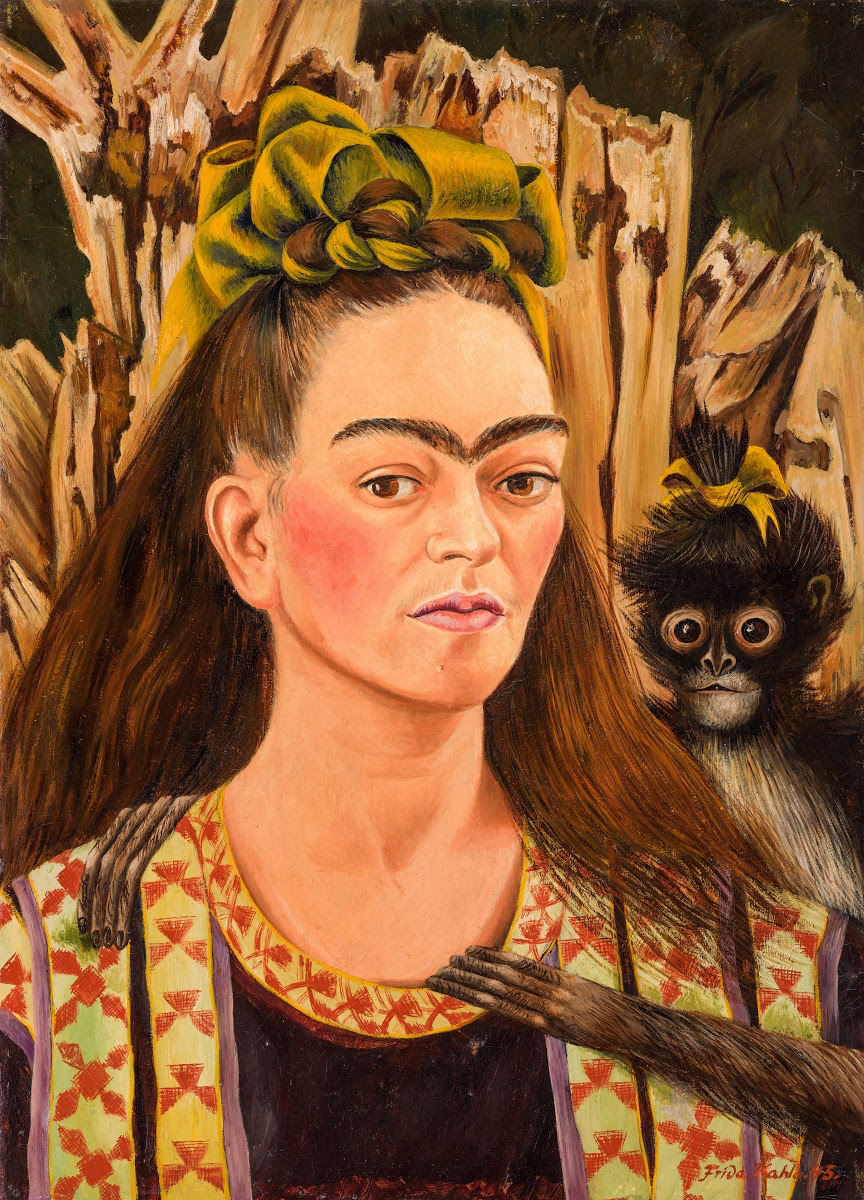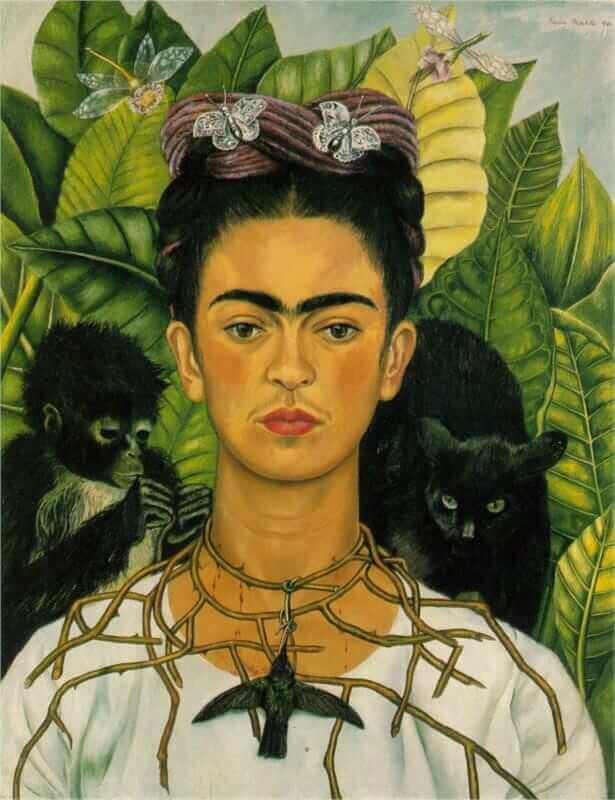弗里达·卡罗:《与猴子一起的自画像》(1945)

Frida's famous self-portraits offer an insight into her troubled inner world, with images that express and reflect on her reality. They have their own symbolism, as it were, and meaning can be inferred from certain clues.
弗里达著名的自画像让观众得以洞察她纠结的内心世界,通过图像表达和反思她的现实性。可以说,它们都有自身的象征意义,而这可以从某些线索中推断出来。
The self-portrait as a mask. Frida's face itself does not openly display the pain and anguish that are latent in her work; her stony expression masks all feeling. In The Mask (1945), Frida chooses to paint the suffering on her face, but she does so ingeniously by using a sorrowful mask which cries bitter, choked tears.
作为一个面具的自画像。不同于作品中隐晦的痛苦和苦恼,弗里达并没有公然表现在脸上;她冷漠的外表掩盖了所有的感情。在《面具》(1945)中,弗里达选择在脸上描绘痛苦,但却巧妙地用一个悲伤的面具来表达。面具在哭泣,掉下苦涩和哽咽的泪水。

The dead tree stump. There is a very dark background covered with leaves on which a large, dried out tree is painted. It is actually a tree stump, the part of the trunk that remains attached to the roots when the tree is cut down. Bare, with its few remaining branches broken, it alludes to both Frida's broken spine and, above all, to death. In another canvas from 1945, Moses or The Solar Nucleus, dried out tree trunks also feature, but with tender buds, as if life were resprouting from old age. In Self-Portrait with Monkey, Frida is one of those trees that, unlike those mentioned above, still has no new branches to offer new life.
死去的树桩。这幅画上有一个覆盖着树叶的黑暗背景,上面画着一棵干枯的大树。它实际上是一个树桩,树被砍倒时依附在树根上的树干部分。树桩光秃秃的,仅剩的几根树枝也断了。这里有着双重暗示,一方面是弗里达破裂的脊柱,更重要的是还代表死亡。在她1945年创作的其他油画作品《摩西》或《太阳核心》中,干枯的树干也很突出,但有嫩芽,仿佛生命从老年开始重生。但不太一样的是,在《与猴子的自画像》中,弗里达将自己看作没有新的树枝来孕育新生命的树之一。
The Tehuana dress. As per custom, her chosen clothing is an embroidered Tehuana huipil, the traditional dress of indigenous women. This example is made of black velvet. The Tehuana dress was Diego's favorite, and in itself conveyed the wearer as a strong woman, of equal or superior social stature to any man.
特瓦娜连衣裙。按照惯例,她选择的服装是刺绣特瓦娜连衣裙,这是墨西哥原住民妇女的传统服装。这幅画中的裙子是用黑丝绒做的。特瓦娜连衣裙是迭戈的最爱,并且它本身就传达了穿着者是一个强壮的女人,具有与任何男人同等或更高的社会地位的概念。
The hairstyle. The ends of Frida's hair fall loosely behind her, like a veil, while the rest is gathered on top of her head, plaited with a green ribbon.
发型。弗里达的发梢像面纱一样松散地垂在身后,而其余的头发则聚集在她的头顶,用绿色的丝带编在一起。
The green ribbon. The dull green tone reflects for her the color of the leaves and of sadness: Frida is in mourning.
绿色丝带。她用暗绿色的色调表现了树叶的颜色和悲伤的情感:弗里达在哀悼。
The unibrow bird. Above her tense features, overloaded with restraint, is one of Frida's most identifying attributes: her unibrow. It is so prominent that it resembles a bird: herself as a bird with outstretched wings, free at last.
单眉鸟。除了过度克制的紧张特征之外,弗里达最具辨识度的点还在于她独特的眉毛。它非常突出,就像一只鸟:她自己像一只张开翅膀的鸟,终于获得自由。
The monkey. Frida has a spider monkey as her companion. She proudly presented her Fulang Chang in 1937, and went on to appear with monkeys in 8 self-portraits. The creatures accompany her, wrap her up, and cross their long arms over her chest, mirroring the shawls she crosses over her body, or the cartridge belts worn by the Adelitas in the Mexican Revolution.
猴子。弗里达有一只蜘蛛猴与她相伴。1937年,她骄傲地展示了她的Fulang Chang,并继续与猴子一起出现在之后的8幅自画像中。这些动物陪伴着她,缠绕着她,在她的胸前交叉长臂,就像她身上的披肩,或者是墨西哥革命中阿黛丽塔人穿的弹带。

The little alter ego. The little monkey is small, thin, and hairy, much like Frida, and also like her has dark hair. Their headdresses also match. He is a little alter ego that comforts her, takes care of her (for example removing the thorns in the Self-Portrait with Thorn Necklace and Hummingbird, 1940), and here he sits behind her to support her.
小第二自我。小猴子又小又瘦,长满了毛,很像弗里达,也像她一样有一头黑发。他们的头饰也很相配。他是一个可以安慰她、照顾她的小第二自我(例如《戴荆棘和蜂鸟项链的自画像》中帮她去掉荆棘,1940年),在这幅画里,它坐在她身后支持她。

The brushstrokes and color. With each delicate brushstroke, Frida conclusively registers, one by one, every minute detail of herself and her surroundings. Her palette is dominated by sad, dark, muted, and earthy tones, while the bursts of color in her dress depict pain: the bleeding red of the decorations, and the purple of the ribbons, the same color as her lips.
笔触和色彩。弗里达一笔一笔地用细腻的笔触记录下自己和周围环境的每一个细节。她的调色板被悲伤、黑暗、柔和和泥土色调所主宰,而她衣服上色彩的爆发反映了痛苦:鲜红的饰品,紫色的丝带,还有嘴唇。
The signature. The only vibrant brushstrokes used are those for her signature. This is no accidental detail; Frida leaves nothing to chance. Through the entire painting she has shown herself to be dark, sad, rigid, and hard, whereas her final brushstrokes are a fiery red, evoking life, but also suffering.
签名。她的画作上唯一充满活力的笔触是她的签名。这不是碰巧的细节;弗里达没有留下任何偶然。在整幅画中,她表现出自己是黑暗的、悲伤的、僵硬的、坚硬的,而她最后的笔触是火红的,唤起了生命,但也带来了苦难。
Frida multiplies. With the tree stump, the monkey, the dress, the headdress, and even the face, managed like charms, Frida multiplies, spreading into each corner of the painting and expanding. All this comes together to create one of her most devastating, sad, and distressing images.
很多个弗里达。树桩、猴子、衣服、头饰,甚至脸,都像符咒一样被处理,弗里达成倍地增加,扩展到画作的每个角落。所有这些结合在一起,创造了她最具破坏性、最悲伤、最痛苦的形象之一。
作品馆藏:Robert Brady Museum
原文文字:María Celia Fontana Calvo, Universidad Autónoma of the State of Morelos, Mexico
翻译:八十间房子
喜欢我的作品吗?别忘了给予支持与赞赏,让我知道在创作的路上有你陪伴,一起延续这份热忱!
